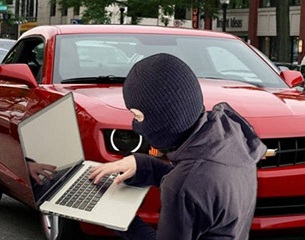Cyber Security
From Car Jacking to Car Hacking: Issues Surrounding the Self-Driving Car
June 10, 2013
Bita Beigishah
 Cars have come a long way since Henry Ford built the first Model-T. In the beginning, they didn’t even have seatbelts, now they have airbags, child-lock doors, automatic windows, alarm systems and advanced electronic features such as built-in GPS, SiriusXM Radio and Bluetooth capabilities. Technology all intended to make our lives easier.
Cars have come a long way since Henry Ford built the first Model-T. In the beginning, they didn’t even have seatbelts, now they have airbags, child-lock doors, automatic windows, alarm systems and advanced electronic features such as built-in GPS, SiriusXM Radio and Bluetooth capabilities. Technology all intended to make our lives easier.
This technology is also emerging to make cars truly safer and more reliable. Car commercials today advertise vehicles with the ability to automatically apply the brakes or make the driver’s seat vibrate if the car detects something in a blind spot.
The only logical next step for cars to take would be total control of the driving environment and Google has it covered. Google is hard at work testing prototypes of a self-driving car in which all you need to do is get in and tell it where you wish to go. However, the only trouble with that is that as cars become more connected – to the Internet as well as to each other – cyber security threats will increasingly rise.
Cyber Security
The National Highway Traffic Safety Administration (NHTSA) predicts that by the year 2020, cars with select self-driving features will be available to consumers and by the year 2025, fully-automated self-driving cars will hit the market in large numbers, reports the Wall Street Journal. Of course there is much more research to be done, and currently these cars are only allowed on the roads for testing purposes but this is where automotive technology is headed.
But this innovation leads to many questions, mainly in terms of responsibility. The goal of these cars is to make driving safer and prevent injury and death. But accidents do happen; computers freeze and crash. Is it likely this will happen to automated cars as well? And if so, whose fault is it should there be an accident?
And while the safety and reliability of these cars is very important, the security of them is also a hot topic. According to an article on AutoNews.com, today’s standard luxury car has over 100 million lines of computer code. Just to provide a little perspective, a typical computer game only has between one and two million. All those lines make hacking inevitable and a serious issue.
What might happen if someone were to hack into one of these cars and take control of it? Or what if multiple cars were to get hacked? The results could be disastrous.
NHTSA Regulation
Because cars are evolving to become more like computers on wheels, the National Highway Traffic Safety Administration is creating a new department to address the associated threats. The goal is to monitor this new technology and stay up-to-date on any safety and cyber security concerns.
According to Edmunds.com, the Electronics Systems Safety Research Division will be in charge of identifying preliminary threats and coming up with possible solutions. The Division will also set requirements for self-driving cars such as the ones being developed and tested by Google.
For such cars as these, NHTSA has outlined five levels of “self-driving technology,” according to a Wall Street Journal article. They range from Level 0 where the driver is in complete control of the vehicle at all times, to Level 4 where the car essentially makes the driver nothing more than a passenger. The article says that the Google self-driving car, which uses laser technology and Google Maps to function, would be classified as Level 3 because the driver still has the ability to override the car’s automated operations.
Whether or not the world is ready for self-driving cars is still not clear yet; but surely everyone can agree that between sitting in rush hour and poor drivers on the roadways this idea has its perks.
subscribe by email
Stay Ahead
Related Posts
-
Cyber Security
Cybersecurity Mindful Moments by Tara Lemieux
February 7, 2023
-
Cyber Security
Boost your Cyber Security Awareness
December 13, 2021
-
Cyber Security
Why You Should Invest in Cyber Security
September 8, 2021
